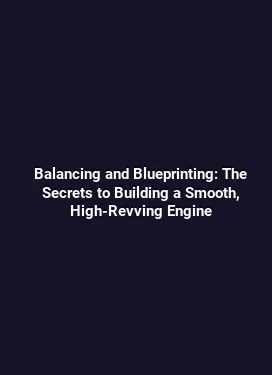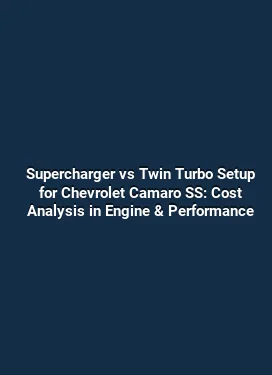The Lifespan of Boost: When to Upgrade Your Turbocharger or Supercharger
Understanding the Lifespan of Boost Components

Boost systems, whether turbocharged or supercharged, operate under extreme conditions. The core components—turbines, compressors, housings, bearings, seals, and the associated plumbing—are subjected to high temperatures, pressure spikes, and rapid load changes. A well-designed system with quality components paired to a suitable engine build tends to deliver reliable performance over thousands of miles, but variability exists based on driving style, installation quality, maintenance habits, and the intended use of the vehicle. When discussing lifespan, it is essential to separate fundamental durability from performance goals. A turbocharger or supercharger may outlive the vehicle’s body while still requiring refreshment to maintain peak efficiency, or conversely, a heavy-footed application might accelerate wear beyond typical expectations.
The lifespan of boost devices is often quoted in miles, operating hours, or boost cycles. In daily driving, a modern turbocharger can cover well over 100,000 miles with minimal attention if it remains within design tolerances and the engine is well-tuned. In high-performance or track-focused builds, lifespans can be shorter due to sustained high boost, elevated exhaust gas temperatures, and more aggressive shifts in RPM. Understanding the interaction between boost strategy and engine health helps set realistic expectations for maintenance windows and upgrade timelines.
The practical takeaway is that longevity hinges on matching the boost technology to the engine’s internal capabilities, keeping temperatures in check, maintaining clean lubrication, and avoiding operating regimes that push the system beyond its intended limits. Clear metrics such as compressor efficiency, turbine outlet temperature, bearing wear, and seal integrity are the typical indicators technicians monitor when assessing remaining life.
Key Factors Influencing Component Longevity
Several interrelated factors determine how long a turbocharger or supercharger will serve reliably. Evaluating these factors helps an owner decide when upgrading or refreshing parts makes sense rather than waiting for a failure. These considerations span the hardware itself, the supporting systems, and the way the vehicle is operated.
First, thermal management plays a dominant role. Turbochargers rely on fast heat transfer to harness exhaust energy. Excess heat, poor intercooling, or heat soak during sustained boost can degrade turbine materials and lubricating oil. An effective intercooler, properly sized piping, and efficient charge air cooling minimize thermal cycling and reduce the risk of detonation or pre-ignition, which are costly conditions that shorten boosting components’ life.
Second, lubrication quality and oil temperature govern bearing life and seals. Boost devices spin at extreme speeds; a high-grade synthetic oil with appropriate viscosity and a reliable oiling system are essential. Oil starvation or sludge buildup can cause accelerated wear, especially on journal bearings and rotor assemblies. Regular oil changes with manufacturer-approved intervals and using the correct spec for boosted engines is a foundational habit for longevity.
Third, mechanical design and build quality matter. Factory turbochargers may use ceramic ball bearings for lightness and rapid response, while some high-performance units employ dual-ball bearings with larger center sections for greater durability. Billet wheels, robust seals, and reinforced housings contribute to longer lifespans, especially under aggressive boost curves. A properly engineered upgrade that maintains or improves thermal and mechanical stability can extend service life when matched to the engine.
Fourth, boost strategy influences wear. A smooth, well-tuned boost curve reduces sudden peak pressures and minimizes surges that stress the turbocharger and exhaust manifold. Forced induction systems with conservative boost targets and efficient wastegate control tend to wear more gracefully than those chasing peak numbers without regard for exhaust temperatures or fuel quality. That balance between performance and reliability is central to deciding when an upgrade is warranted.
Fifth, installation quality cannot be overstated. Proper alignment of the turbine and compressor housings, leak-free charge pipes, correctly calibrated wastegates, and secure mounting minimize vibrations and mechanical fatigue. Inadequate clearances or misfitting components can cause premature wear, boost instability, and accelerated seal leakage. A professional installation with attention to tolerances yields a longer, more predictable service life.
How Wear Presents Itself in Real-World Scenarios

Owners often notice signs of aging before a catastrophic failure occurs. For turbocharged systems, symptoms include gradual boost creep, turbine whine at varying RPMs, or delayed boost response after idle. In supercharged setups, you might observe belt wear, pulley wobble, or belt slip during high-load events. These indicators generally point to lubrication concerns, belt tension issues, or bearing wear. Regular inspection during routine maintenance can catch developing problems early, allowing planned upgrades rather than unexpected breakdowns.
Another practical signal is reduced response under boost, which may result from compressor wear, turbine housing leakage, or intercooler inefficiency. Monitoring boost pressure, air-fuel ratio, and exhaust gas temperatures during dynamic driving helps isolate the source. Advanced data logging can reveal subtle trends such as gradual compressor flow degradation or rising temperatures during steady-state cruising, both of which warrant attention before power loss becomes noticeable on the road or track.
When to Consider Upgrading: Practical Guidelines
Deciding to upgrade a turbocharger or supercharger involves weighing reliability, performance goals, engine compatibility, and budget. A thoughtful upgrade strategy considers how far the current system is from meeting the new objectives and whether the supporting components are capable of handling the increased demands. The following guidelines provide practical decision points for enthusiasts and professional tuners alike.
First, assess the engine’s age and maintenance history. A well-maintained modern engine with proven boost compatibility can respond positively to a controlled upgrade. In contrast, an aging bottom end or worn fuel system can negate the gains from a more capable blower or turbo. Before upgrading, verify compression consistency across cylinders, fuel delivery capacity, and the integrity of the cooling system. If the core engine is already near its operational limits, strengthening the rotating assembly or upgrading fuel and ignition systems often yields a better long-term balance than simply increasing boost.
Second, evaluate your use case. Daily drivers seeking noticeable performance without sacrificing reliability may benefit from a moderate upgrade paired with a robust cooling and fueling plan. Track-day enthusiasts or weekend racers who operate under sustained boost conditions should consider a more deliberate upgrade path, including a larger turbocharger or a high-output supercharger matched to a fortified intercooling solution and upgraded exhaust and intake paths. The goal is to maintain safe ignition timing and stable air-fuel ratios while avoiding heat-soak and detonation phenomena.
Third, consider the boost strategy and control hardware. A modern boost controller, a reliable wastegate actuation system, and precise air metering ensure that the upgraded unit remains within safe operating envelopes. Upgrades often involve recalibrating the engine management software or using a dedicated engine control unit (ECU) tune designed for the specific turbocharger or supercharger model. Proper calibration ensures optimal efficiency, reduces emissions, and protects the engine from knock events that could shorten lifespans.
Fourth, plan for supporting mods. Enhanced intercooling, upgraded intake piping, larger fuel injectors, higher-capacity fuel pumps, and improved exhaust flow help the boosted system achieve its goals without pushing components beyond reasonable limits. A balanced package prevents bottlenecks that could otherwise limit the upgrade’s benefits or invite reliability issues. In particular, intercooler pressure drop, intake manifold design, and exhaust backpressure all influence thermal stability and response times, shaping the decision to upgrade.
Fifth, factor maintenance and service intervals. Upgraded components often demand more frequent inspection, especially fuel, lubrication, and cooling subsystems. A maintenance plan that includes regular oil analysis, coolant condition checks, and boost leak testing ensures the upgrade remains reliable over time. Owners who schedule periodic system checks are more likely to experience consistent performance and longer component life than those who adopt a “set it and forget it” approach.
Upgrade Scenarios: Real-World Examples
Consider a street-oriented car with a factory turbo that has logged over 80,000 miles. The owner desires stronger mid-range torque without sacrificing daily drivability. A practical upgrade path may involve selecting a slightly larger, well-matched turbocharger, upgrading the intercooler, and tuning for a safe increase in boost pressure. In this scenario, the engine’s internals, fuel system, and cooling must be aligned to prevent detonation or lean conditions. The result is improved power delivery across the RPM band while preserving reliability and drivability.
In another case, a track-focused vehicle with a supercharger experiencing belt slip and belt wear after several hundred hours of hard use could benefit from a higher-grade belt system, a redesigned pulley for consistent boost delivery, and reinforced tensioning. Pairing this with improved cooling and a tuned fuel map helps maintain stable operation under peak loads. Such upgrades typically extend the life of the boosted system by reducing stress points and ensuring consistent performance through laps or repeated high-boost cycles.
For those pursuing ultimate durability, some builders opt for features like load-bearing billet components, reinforced seals, and robust bearing configurations. While these choices add upfront cost, they can reduce maintenance frequency and improve reliability in extreme boost environments. A well-planned upgrade also accounts for emissions compliance and warranty considerations, integrating modern control strategies that monitor temperatures, boost targets, and engine health metrics in real time.
Maintenance Habits That Preserve Boost Lifespan
Preserving the lifespan of turbochargers and superchargers hinges on disciplined maintenance. Routine checks and proactive replacement of wear-prone parts can prevent catastrophic failures and keep performance consistent. The following maintenance practices are widely effective across boost types and vehicle platforms.
First, stick to a rigorous lubrication routine. Use high-quality engine oil that meets the manufacturer’s specification, and adhere to the recommended change interval. Oil cleanliness and pressure stability are crucial for bearing longevity. In high-boost applications, consider shorter intervals or oil analysis to detect early signs of wear or contamination.
Second, monitor charge air cooling. Ensure the intercooler system is free of leaks and capable of maintaining cool charge temps under load. Clean or replace clogged intercoolers and check all couplings for pressure integrity. Ducting and clamps should be secure to prevent boost leaks that force the system to work harder and generate excess heat.
Third, inspect seals, gaskets, and lines for signs of wear. Boost hoses and intercooler end-tanks can develop cracks or leaks, which degrade performance and lead to lean conditions. Regularly verify that clamps remain tight and that silicone or metal piping is free from cracks and signs of fatigue. A small leak in the charge system often results in reduced efficiency and thermal stress elsewhere in the system.
Fourth, verify the wastegate operation and boost control. A faulty wastegate or a miscalibrated boost controller can cause over-boost or lag, both of which are detrimental to longevity. Periodic calibration checks and, when necessary, a fresh calibration tune help maintain predictable boost behavior, protecting engine health and ensuring the upgraded system functions as intended.
Fifth, perform proactive diagnostics. Use data logging to track boost pressure, air-fuel ratio, exhaust gas temperature, and turbine outlet temperature. Anomalies such as excessive EGT or a rising trend in fuel trims often indicate developing issues that warrant early attention. Timely diagnosis reduces the chance of sudden failures and supports informed upgrades when the time is right.
Compatibility and Considerations for Future Upgrades
Choosing a new turbo or supercharger is not only about peak numbers. Compatibility with the engine, transmission, exhaust, fuel system, and electronics is essential for a coherent upgrade. The following considerations help ensure a successful transition to higher performance while preserving reliability and drivability.
First, evaluate engine internals, including the piston and rod strength, rod bearing clearances, and cylinder wall integrity. A higher boost level or larger displacement in the boosted path places greater demands on the bottom end. If the engine exhibits signs of aging, addressing these elements as part of the upgrade package reduces the risk of later issues.
Second, align fuel and ignition systems with the new boost targets. More boost typically requires higher fuel flow and precise timing to prevent detonation. Upgrading injectors, fuel pumps, and ignition components, along with a robust ECU calibration, helps maintain safe operation and unlocks the potential of the boosted setup.
Third, ensure the cooling system is capable of handling the added heat. Whether using a larger intercooler, upgraded radiators, or enhanced thermal management strategies, managing heat is central to maintaining performance and longevity. heat transfer efficiency directly influences turbocharger efficiency and engine reliability under sustained load.
Finally, be mindful of emissions compliance and warranty implications. Some upgrades may affect warranty terms or require specific tuning approaches to meet regulatory standards. Engaging with a reputable shop that understands modern electromagnetic compatibility concerns and drivetrain integration helps protect the investment and minimizes compliance risk.
Summary of Practical Takeaways
Upgrading turbochargers or superchargers is a nuanced process that benefits from a holistic view of the entire powertrain. Understanding the interplay between thermal management, lubrication, mechanical design, and control strategies enables smarter upgrade decisions. With careful planning, appropriate supporting modifications, and a disciplined maintenance routine, boosted engines can deliver sustained performance gains while maintaining reliability and longevity.
Owners who monitor wear indicators, maintain clean lubrication, manage heat effectively, and select compatible components experience the most predictable outcomes. The lifespan of boost components is not a fixed number; it is a function of how well the entire system is engineered, installed, and cared for over time.






